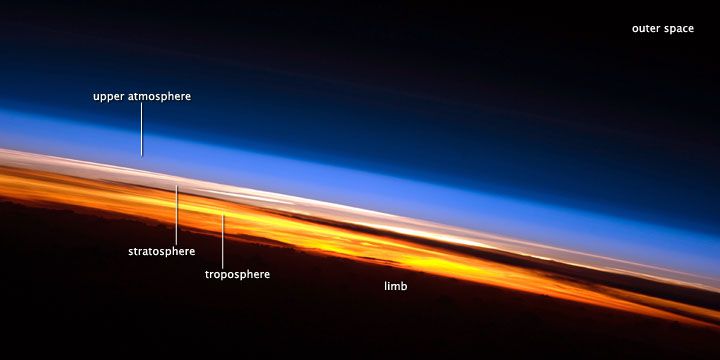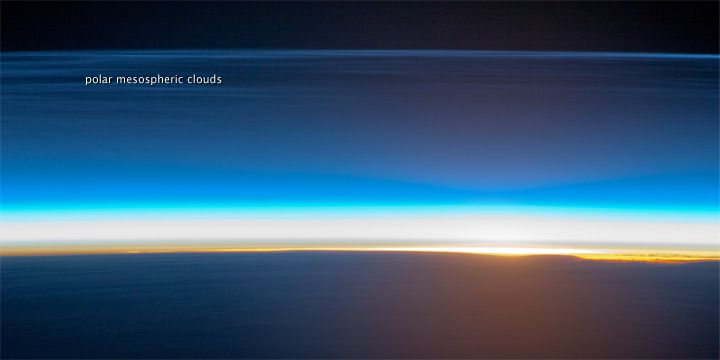Earth’s Atmosphere

This spectacular image of sunset on the Indian Ocean was taken by astronauts aboard the International Space Station (ISS). The image presents an edge-on, or limb view, of the Earth’s atmosphere as seen from orbit. Read more at NASA.
NASA has another view highlighting polar mesospheric clouds which occur near the boundary between the mesosphere and thermosphere atmospheric layers.

Composition of the Atmosphere
AC 00-6b Aviation Weather
1.3.1 Troposphere. The troposphere begins at the Earth’s surface and extends up to about 11 kilometers (36,000 feet) high. This is where we live. As the gases in this layer decrease with height, the air becomes thinner. Therefore, the temperature in the troposphere also decreases with height. As you climb higher, the temperature drops from about 15 °C (59 °F) to -56.5 °C (-70 °F). Almost all weather occurs in this region.
The vertical depth of the troposphere varies due to temperature variations which are closely associated with latitude and season. It decreases from the Equator to the poles, and is higher during summer than in winter. At the Equator, it is around 18-20 kilometers (11-12 miles) high, at 50° N and 50° S latitude, 9 kilometers (5.6 miles), and at the poles, 6 kilometers (3.7 miles) high. The transition boundary between the troposphere and the layer above is called the tropopause. Both the tropopause and the troposphere are known as the lower atmosphere.
1.3.2 Stratosphere. The stratosphere extends from the tropopause up to 50 kilometers (31 miles) above the Earth’s surface. This layer holds 19 percent of the atmosphere’s gases, but very little water vapor.
Temperature increases with height as radiation is increasingly absorbed by oxygen molecules, leading to the formation of ozone. The temperature rises from an average -56.6 °C (-70 °F) at the tropopause to a maximum of about -3 °C (27 °F) at the stratopause due to this absorption of ultraviolet radiation. The increasing temperature also makes it a calm layer, with movements of the gases being slow.
Commercial aircraft often cruise in the lower stratosphere to avoid atmospheric turbulence and convection in the troposphere. Severe turbulence during the cruise phase of flight can be caused by the convective overshoot of thunderstorms from the troposphere below. The disadvantages of flying in the stratosphere can include increased fuel consumption due to warmer temperatures, increased levels of radiation, and increased concentration of ozone.
1.3.3 Mesosphere. The mesosphere extends from the stratopause to about 85 kilometers (53 miles) above the Earth. The gases, including the number of oxygen molecules, continue to become thinner and thinner with height. As such, the effect of the warming by ultraviolet radiation also becomes less and less pronounced, leading to a decrease in temperature with height. On average, temperature decreases from about -3 °C (27 °F) to as low as -100 °C (-148 °F) at the mesopause. However, the gases in the mesosphere are thick enough to slow down meteorites hurtling into the atmosphere where they burn up, leaving fiery trails in the night sky.
1.3.4 Thermosphere. The thermosphere extends from the mesopause to 690 kilometers (430 miles) above the Earth. This layer is known as the upper atmosphere.
The gases of the thermosphere become increasingly thin compared to the mesosphere. As such, only the higher energy ultraviolet and x ray radiation from the sun is absorbed. But because of this absorption, the temperature increases with height and can reach as high as 2,000 °C (3,600 °F) near the top of this layer.
Despite the high temperature, this layer of the atmosphere would still feel very cold to our skin, because of the extremely thin air. The total amount of energy from the very few molecules in this layer is not sufficient enough to heat our skin.
1.3.5 Exosphere. The exosphere is the outermost layer of the atmosphere, and extends from the thermopause to 10,000 kilometers (6,200 miles) above the Earth. In this layer, atoms and molecules escape into space and satellites orbit the Earth. The transition boundary that separates the exosphere from the thermosphere is called the thermopause.


